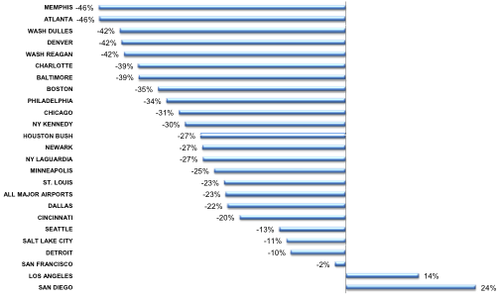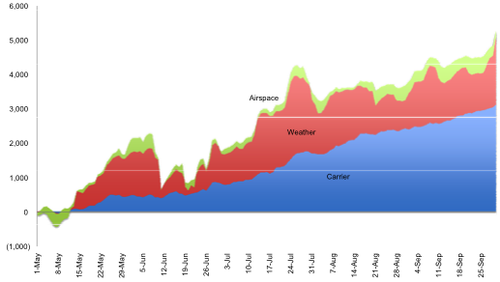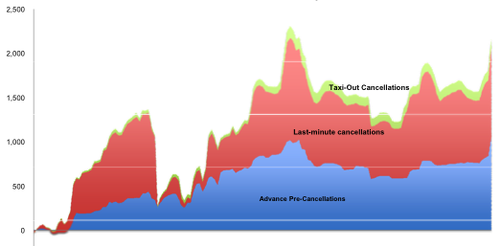Study indicates tarmac rule still doing damage
While the Department of Transportation can rightly congratulate itself for the near elimination of tarmac delays in the US, a follow-on study of the unintended consequences of the five-month-old tarmac delay rule, confirmed earlier analysis that airlines are forced to cancel more flights rather than risk a fine.
The study found the rule drove an increase in cancellations by 5064 flights, up 18%, stranding 384,356 passengers on those flights compared to the 59,000 passengers affected by tarmac delays. Including non-reporting carriers such as Virgin America and Spirit Airlines, the number of passengers hit by cancellations rose to more than 521,500 passengers.
The study also calculated the fines which could reach USD1.5 million, a fine ratio of 366:1, for a 70-seat regional jet and USD3.2 million (231:1) for a B737 for a flight that could be carrying only USD30,000 in revenue.
But the most astounding revelation was the fact that airlines remain confused as to whether the fine will be assessed per passenger or per flight, something the DOT has yet to clarify in nearly a year since the tarmac rule was first announced. The rule calls for the fine per violation but doesn't define what a violation means. DOT told the Centre for Aviation that the fine "might be assessed per passenger if litigated before an administrative law judge". So, it seems, it is waiting for a test case before doing something as simple as clarifying what the authors of the regulation really meant.
Issuing a clarification, say the study authors - Airline Zone President Darryl Jenkins and Marks Aviation Principal Joshua Marks - would go a long way in mitigating the rising number of cancellations. "FAA routinely provides such guidance," said Jenkins, adding the DOT should, too.
"Airlines operate under the assumption that the violation is assessed on a per-passenger basis," they said. "The fines are disproportionate to revenue, which could be far less than USD27,500 per flight. A survey of airlines conducted in November 2010 confirms that airlines initiate returns to gate as early as 90 minutes after gate departure to avoid fine exposure. This leads to flight cancellations that can and should be avoided under the consumer protection objectives of the rule. The variability of taxi-in times at airports, particularly during weather conditions and airspace events that cause long on-board delays, has combined with the threat of multi-million-dollar fines to drive conservative decisions in gate returns. The number of gate returns has risen by 19%. As a result, data shows more than 75% of the increase in cancellations can be traced to last-minute cancellation decisions made by airlines either to avoid tarmac exposure or to free gate capacity for flights returning to gate."
Sep-2010 on time arrivals down 5ppts year on year
DOT reported this week that US carriers recorded an overall on-time arrival rate of 85.1% in Sep-2010, down from the 86.2% on-time rate of Sep-2009 but up from Aug-2010's 81.7%.
In Sep-2010, 4.81% were attributed to aviation system delays, compared to 5.07% in Aug-2010 4.60% by late-arriving aircraft, compared to 6.42% in Aug-2010, 3.99% by factors within the airline's control, such as maintenance or crew problems, compared with 5.16% in Aug-2010; 0.41% by extreme weather, compared with 0.46% in Aug-2010. Weather is a factor in both the extreme-weather category and the aviation-system category.
In Sep-2010, 34.53% of late flights were delayed by weather, down 0.17% from Sep-2009, when 34.59% of late flights were delayed by weather, and down 1.54% from August when 35.07% of late flights were delayed by weather.
DoT's head firmly in the sand
DOT has been reticent to even entertain the thought that the rule might be flawed. Even so, its own statistics show cancellations doubling. But DOT has been twisting itself upside down and sideways refusing to admit to what its own statistics are saying - as illustrated by the exquisite exchange it had with "cranky flier" Brett Snyder. Snyder posted a chart sent from DOT which was trying to prove the delay rule is working. However, DOT clearly did not count on Snyder's interpretation.
"What I saw was a doubling of the rate of cancellations when flights were held on the ground for more than two hours," he wrote.
While the data does show fewer cancellations of flights experiencing two-hour-plus delays from May through August compared to the same period in 2009, Snyder quickly caught on to the fact that it also shows that those flights are more than twice as likely to be cancelled this year than they would have been in 2009. "That, to me, seems like proof that the ground-delay rule is causing cancellations," he wrote. "Last year, of those flights, 4-8% were cancelled in any given month. But this year, it's 10-14%. Without having the airlines give us specific numbers, this is the closest I've seen to something showing that there without a doubt have been more cancels this year because of the rule."
The conclusion is exactly what Jenkins and Marks found: cancellations are happening much further out and the rule is forcing many of those that do return to the gate to be cancelled.
Despite DOT's head-in-the-sand approach, Jenkins reported that legislators have showed interest in their reports. Meanwhile, advocates of the tarmac delay rule see no problem with increasing delays because it spared people from having to sit on airplanes interminably. However, there is a significant cost to passenger delays which have reached USD40 billion a year at the peak of the business cycle.
At the time of Jenkins/Marks earlier report, DOT criticised the independent study as not having enough data although it studiously avoided responding to the fact that cancellations were up. It won't be able to make that same complaint about data this time given the fact that authors Jenkins and Marks - two self-described airline data geeks - developed a data base covering a decade and resulting in 100 million lines of data or two terrabytes that afforded the most comprehensive analysis of delays that has ever been done.
"The five-month period from May through September offers a statistically meaningful sample of tarmac delays for analysing trends," the report said. "During 2009, more than 60% of annual tarmac delays occurred during this five-month window. Similar trends are observable in prior years."
The previous study, published in July, showed that while tarmac delays were down, cancellations and the number of disrupted passengers that resulted far outweighed those that would have been affected if the delay rule had never been implemented.
Tarmac delay rules to cost the public welfare USD4 billion
The Airline Zone/Marks Aviation study
The Airline Zone/Marks Aviation study - Summer 2010 Cancellations and the Five-Month Impact of the Three-Hour Rule - covered May-September, concluding, while the rule reduced tarmac delays by 532 flights, it "shows that threatened multi-million-dollar fines and conflicting regulations are causing significant consumer harm."
What was particularly disturbing was the fact cancellations rose despite the fact weather was unusually good and there were no systemic ATC issues, meaning many of the reasons for delays were off the table, except for the threatened fines. Analysis of airport samples taken each quarter hour showed conditions were 30% more favorable than usual. That means, unless the rule is revised or better guidance issued by the department, next summer will be far worse.
Normalized Weather Comparison, 2010 versus 2009 Monthly Weather Impact versus prior year, normalized for 2006-2008
% Change in Inclement Weather, May-Sep 2010 vs. 2009
"Despite the best weather in a decade and fewer planes in the sky, airlines are cancelling flights at far greater rates under the rule than they did before," said the two analysts, who emphasized the study was done pro bono. Indeed, they took umbrage at DOT suggesting this was an airline funded study.
"DOT described us as airline consultants as if that invalidates the research," said Jenkins. "The new tarmac delay rule had good intentions. Facing punitive fines, airlines simply cancel flights that have any exposure to the rule, so thousands of passengers who would not have experienced a long on-board delay are stranded and inconvenienced. The rule is doing more harm than good. DOT used a bazooka to kill an ant."
Indicating the public policy objective of the rule is valid, Marks said, "however unintended, consequences of DOT's rule are growing. There is no question the ant is dead - tarmac delays have ended. But the collateral damage must be addressed quickly for this rule to be sustainable. To put it another way, every day, 3.5 tarmac-delayed flights were eliminated this year, but the equivalent of 18 Boeing 737s were cancelled daily in the process."
Argues wrong-headed assumptions
Jenkins questioned DOT's assumptions in promulgating the rule. "DOT says that tarmac delays are predictable and controllable," said Jenkins. "It also said that airlines would not cancel any more flights when there is more financial risk. In addition, it assumes that gates remain open to accommodate flights returning to the gate and that gate returns don't take that long. DOT also said that pre-cancellations will not rise and passengers can easily be re-accommodated."
What the study found, he said, is that gate returns typically take 64 minutes.
Cumulative Change in Cancellations by Cause May through Sep 2010 vs. 2009, by Day
The study indicated a 25% increase in cancellations for flights with exposure to tarmac fines and similar increases in cancellations before gate departure and at diversion airports. At key hub airports, the increases in cancellations are even more significant.
Change in Flight Cancellations, May-Sep 2010 vs. 2009
Cumulative Change in Cancellations by Phase: May-2009 to Sep-2010*
Findings in summary
- Gate cancellations (prior to departure, in addition to regular flight cancellations) increased by 4,793 flights year over year as airlines managed exposure to fines by canceling flights before departure.
- An increased number of gate-returning flights now cancel, as crew duty-time restrictions and other factors prevent re-departure for some flights. In 2010, flights with taxi-out times greater than 90 minutes were more than 50% more likely to cancel than in 2009. Gate returns after 30+ minute taxi-out times increased, as did the number and rate of cancellations of those flights.
- At key hub airports, the increase in cancellations is pronounced. At 18 large hubs for Southwest, Delta, United/Continental, US Airways and JetBlue, flight cancellations increased by 24% year over year, or more than 2,900 flights. Flights with taxi-out times greater than 90 minutes were 69% more likely to cancel in 2010 versus 2009.
- Carrier-related factors account for 60% of the increase in cancellations. The change in carrier-related advance cancellations was minimal. There was a significant increase in last-minute cancellations due to Carrier factors as airlines opened gate capacity for flights returning to gate, and cancelled flight operations before departure that were likely to have long taxi-out times. Despite far better weather in 2010, weather-related cancellations were up significantly, both before and after gate departure, and particularly for flights with extended taxi-out times. These trends both strongly suggest that tarmac rule related cancellations have increased significantly.
- Instead of risking a taxi-out or diversion delay where operating conditions would prevent a return to gate by the three-hour mark, airlines have cancelled 1000 more flights at the last minute due to weather conditions versus the same period of 2009, in an environment where weather conditions were significantly more favourable. (See Exhibit 6)
- The ratio of cancellations directly related to the rule appears to be at least four times the number of prevented tarmac delays. System-wide cancellations, which include other factors, have risen by nearly ten times the number of prevented tarmac delays.
Interestingly, the Federal Aviation Administration is in the midst of a notice of proposed rulemaking that could further impact delays and cancellations. Right now, the impact is a bit of a wild card, Marks told CAPA, who explained it does contain an exception exemption to allow crews, approaching the end of their duty day, to continue the flight. "That means gate cancellations could decline," he said. "But pre-cancellations could go up."
"Our objective is not to recommend an immediate end to the tarmac rule," said Jenkins. "As we noted in July, even DOT's Regulatory Impact Analysis suggested that an alternative standard (4 hours) would have higher public benefits than the three-hour rule. The choice of a three-hour limit was political. The question is not whether the three-hour limit, as enacted, prevents long on-board delays. It certainly does. The question is what fallout results from the three-hour standard, and how to adapt enforcement standards and fine structures to minimize unnecessary flight cancellations and ensure that the fewest number of consumers are negatively impacted, either from lengthy on-board delays or from cancelled flights."
Report's recommendations
Since weather delays also increase in the winter, the first thing that needs to be done is to clarify enforcement guidance before the winter seasons begins. Clearly it should not have to wait for a test case before an administrative law judge.
Jenkins and Marks also want DOT to define "when or how passengers (as a group) may waive their rights to deplane, or what specific weather and/or operational conditions constitute a waiver to deplane."
Noting that part of the problem is the lack of frequent updates as to position and sequencing from air traffic control, the authors said some cancellations can be avoided if real-time information were provided more frequently. They noted that the FAA's deployment of Airport Surface Detection Equipment (ASDE-X) gives pilots better position data, but added the system-wide roll-out won't be for years.
"We consistently heard from airlines frustration about receiving real-time information from Air Traffic Control (ATC) regarding aircraft position and sequencing during lengthy on-board delays," it said. "Without clear guidance from tower controllers, who may already be overburdened during bad weather or long delay situations, both pilots and dispatch centers must make conservative decisions, resulting in potentially unnecessary gate returns. While we wait for ASDE-X, both DOT and FAA should ensure that real-time surface movement information is shared with airlines during weather conditions conducive to lengthy on-board delays. That will lead to better decision making at the airline level of when to initiate gate returns. If the tower can confirm, verbally or electronically, that the flight is likely to depart within 30 to 45 minutes, potential cancellations can be prevented."
They called for clarification on the conflict between two reporting rules to which airlines are subject. Indeed, the conflict is so severe, DOT imposing a USD12,000 fine on United, saying it "wasted valuable Department resources." When the government already requires on-time and delay data to be filed with the DOT, then it should not impose an addition and conflicting burden on airlines to report the same data in a different way.
"Enforcement has run amok, with DOT even issuing fines to airlines for over-disclosing information, even when disclosure standards conflict between 14 CFR Parts 234 and 259," said Jenkins.
Marks explained that Part 234 of the Airline Quality Reports requires a monthly report of delays and cancellation whereas Part 259 of the tarmac rule confuses that by defining the delay time to the period when passengers were not offered the option to deplane. Indeed, Jenkins and Marks suggested that is why Pinnacle Airlines has opted out of reporting its on-time performance.
However, Pinnacle said that assumption is false. "We first reported On Time Arrival stats years ago when we were required to," Spokesperson Joe Williams told CAPA. "We continued to do so voluntarily after the rules changed and, presently, we are not required to report them. We plan to reallocate the resources for that reporting into the numerous transition projects needed to bring Mesaba into our operations in 2011."
Comair has similarly opted out because, as with Pinnacle, they have less than 1% of total domestic scheduled service revenue. But there has always been a problem with regional reporting because it becomes misleading they way DOT publishes it. Regionals are nearly always near the bottom of on-time stats but much of the time it is because of the actions of either ATC or their major partners. When things go south at an airport, mainline carriers are more likely to cancel 50- to 90-passenger flight than a 150- to 250-passenger flight. Ditto ATC. In addition, reporting standards have a category for flights that are off schedule but, drilling down into the statistics, shows it is unclear whose fault it was. This has been a problem for years and DOT has consistently resisted efforts to assess fault, letting it look as if regional stats are far worse than they actually may be.
One of the most valuable recommendations from a research perspective is imposing a fifth code to describe delays/cancellations, one specifically relating delays and cancellations to the tarmac rule.
Jenkins and Marks also recommended that, given the length of time to initiate a turn from the tarmac and the difficulty in finding an open gate, DOT should explicitly waive enforcement action when the pilot initiates a return to gate no later than 2.5 hours into an on-board delay.
DOT is considering extending the rule to international flights, but Jenkins and Marks advised against it, saying another full summer of data is needed before such a change is made.





